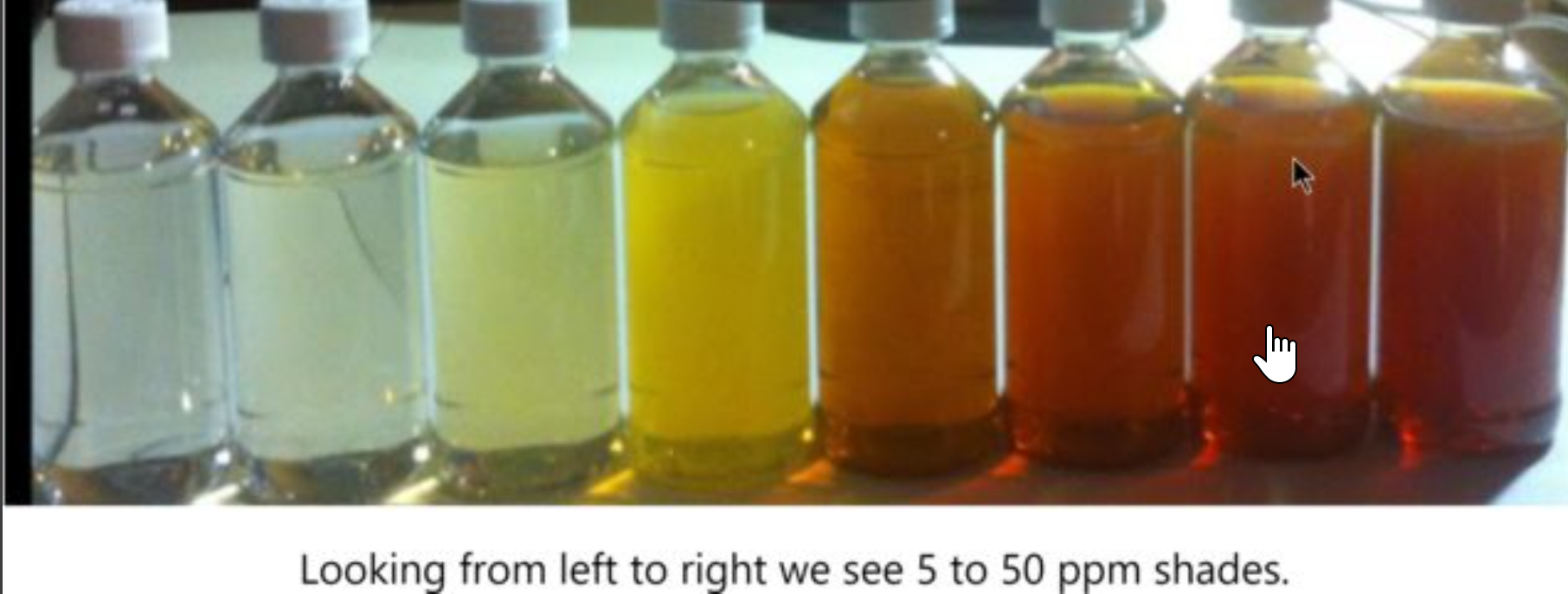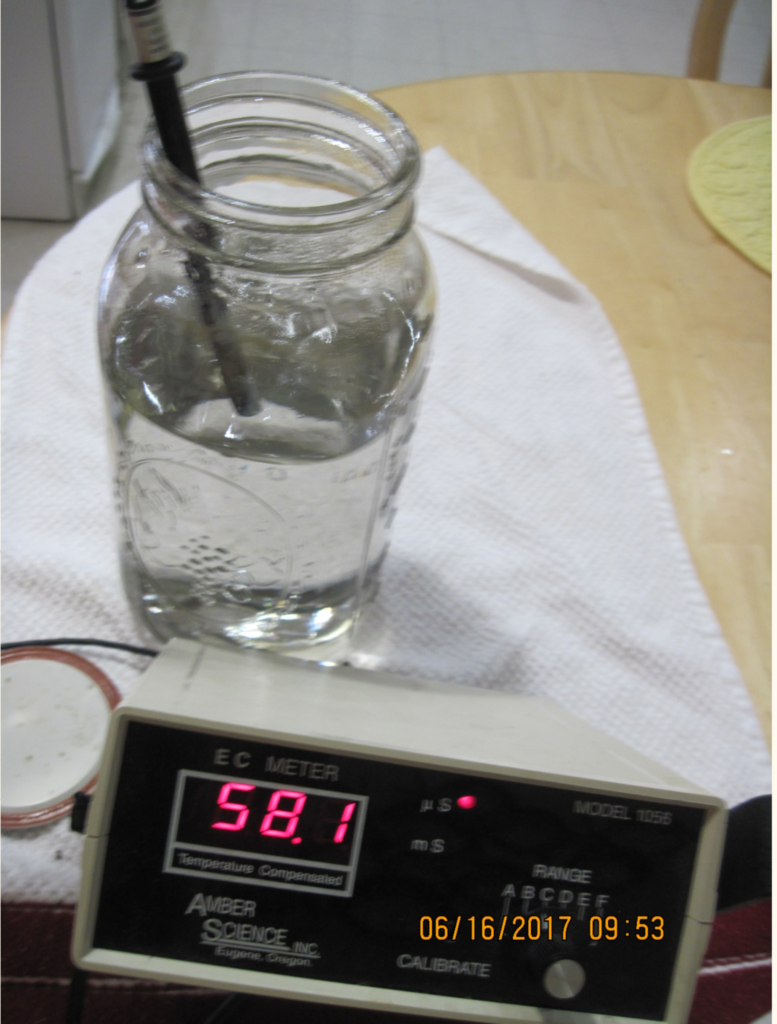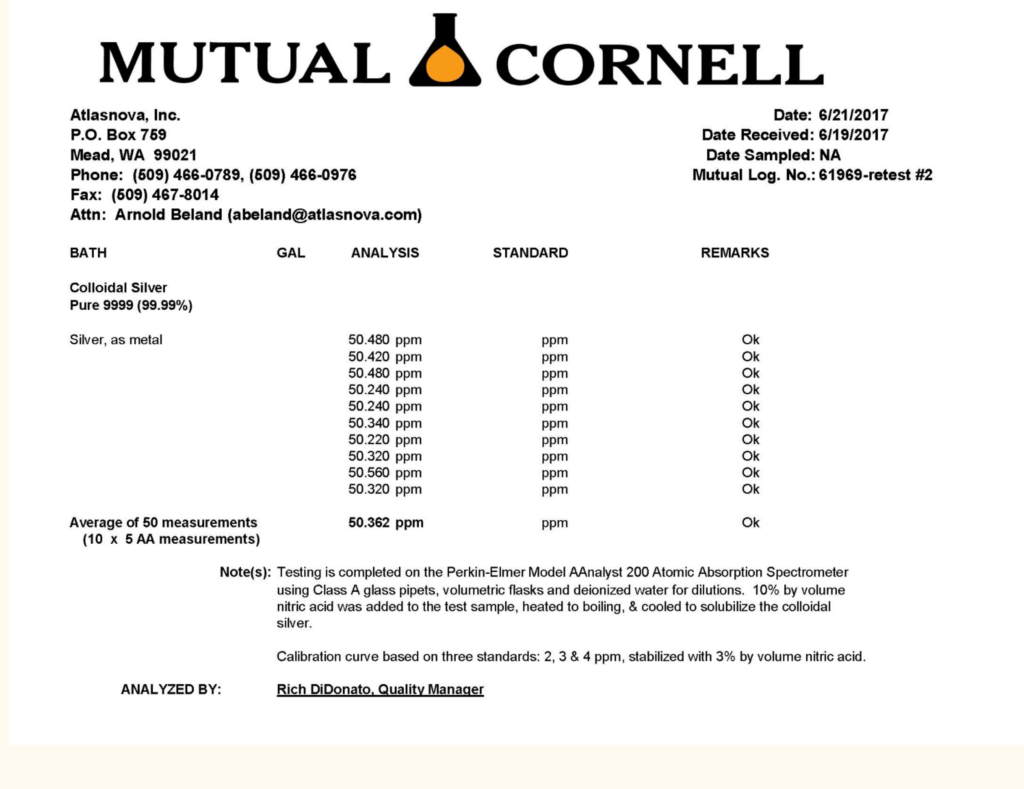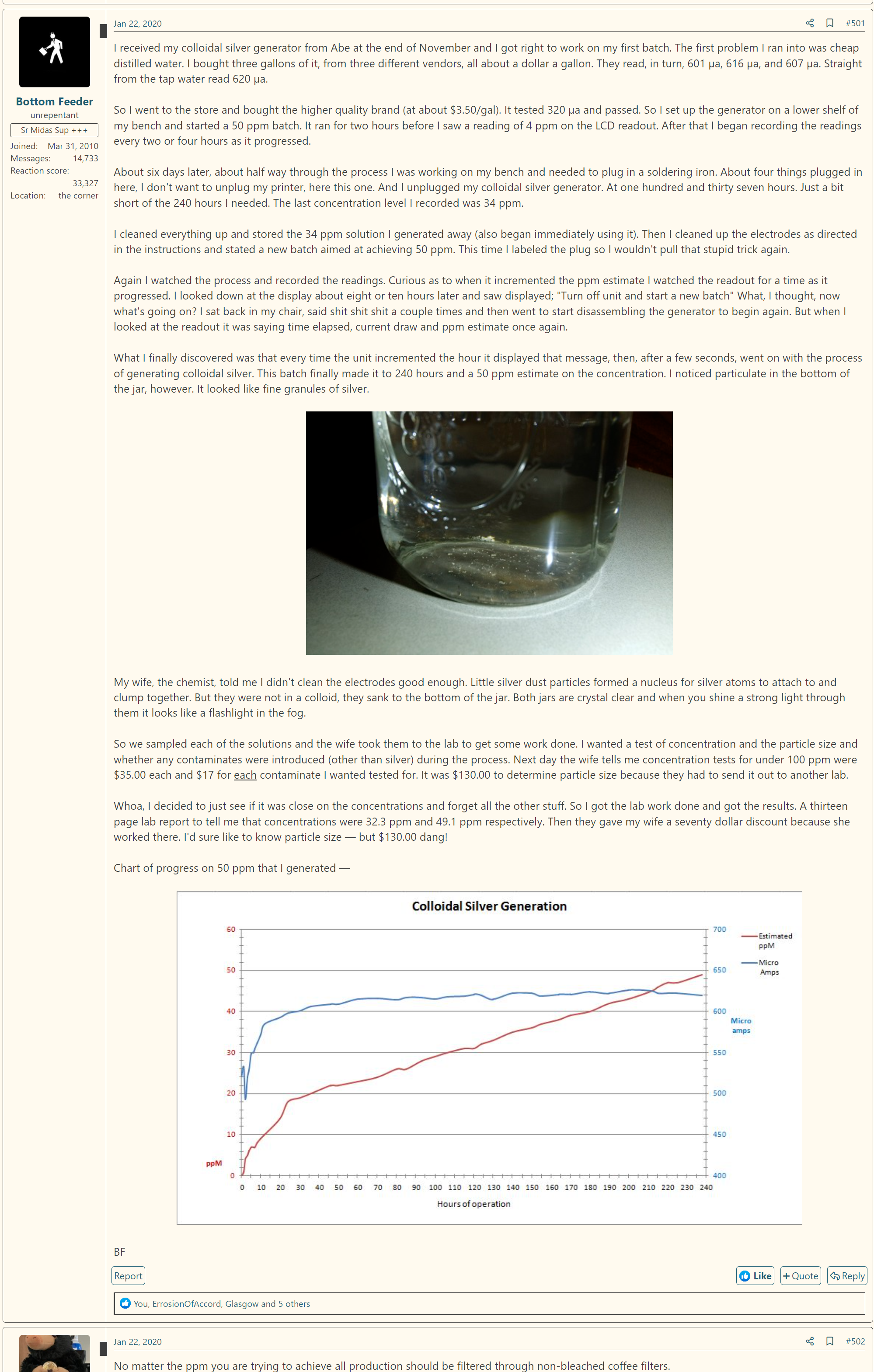In the very early days, when people used salt to speed up making their colloidal silver, they had no idea whether they’d made anything until the solution turned yellow. That indicated that they had made enough large particles to begin to block out the blue spectrum of ambient light, leaving red and green, yielding a yellow tint. The darker the yellow hue, the higher the PPM value. That was true, but it had nothing to do with silver ions and the solution’s ability to kill microbes. Here is a picture of a chart that people used to see what PPM value they had made during that time.

Please note:
These are pictures of chemically produced colloidal silver.
EIS, electrically isolated silver
These are pictures of chemically produced colloidal silver.
EIS, electrically isolated silver, is completely clear up to 50 ppm. We have come a long way since then. I think we’ve come to the point where we should stop using the term colloidal. We have a silver solution with silver ions and individual atoms, not a silver colloid. This change in naming what we want to make would also eliminate the confusion caused by those who include ingredients other than pure water and pure silver. These consist of all sorts of things: proteins, acids, sugars, and who knows what. That enables some marketers to claim very high PPM values. PPM of what? Who knows? It gives the whole effort a bad name. That may be the biggest problem that we have with the FDA. We need to set some standards.
, is completely clear up to 50 ppm.
Here is a link to a good illustration and explanation of the Tyndall effect:
Makers of colloidal silver used the Tyndall effect with a tightly focused light beam before low-cost lasers became available. The many modes of scattering and the exaggerated scattering effect made possible by the laser energy’s coherent nature enabled people to get an idea of the particles they were making in the range up to 1 µm. A laser beam enables the detection of particles beginning in the size of 30 to 40 nm. That allows makers to stop the process before the particles became ever larger and agglomerate to the point where the colloid would turn yellow.
We have come a long way since then. I think we’ve come to the point where we should stop using the term colloidal. With silver ions, individual atoms, we have a silver solution, not a silver colloid. This change in the naming of what we are interested in the making would also eliminate the confusion caused by those who include ingredients other than pure water and pure silver. These consist of all sorts of things, proteins, acids, sugars, and who knows what. That enables some marketers to claim very high PPM values. PPM of what? Who knows? It gives the whole effort a bad name. That may be the biggest problem that we have with the FDA. We need to set some standards. Using the straightforward methods outlined on this thread, we can all make 10 to 15 ppm clear silver solutions reliably. With advanced automated techniques and an extended length of time, we will soon make a 50 ppm clear silver solution. I think it would be of great benefit for us to agree on what we’re trying to accomplish.
So this is what we want to measure, silver ions. Silver ions in a water solution, the version of colloidal silver that we generate, is measured by its conductivity. Pure water is an insulator. Perfectly pure water would have infinite resistance. The inverse of resistance is conductance. The unit of measurement for conductance is the siemen. It is a fortunate coincidence that one part per million of ionic colloidal silver in a solution of water is equal to one microsiemen.
When I started experimenting with making colloidal silver, ionic colloidal silver, a test instrument that measured microsiemens accurately cost thousands of dollars. In the last few years, conductivity meters have become available to do this for under $20. They give us the ability to test colloidal silver. The other way they contested is to make sure that it is clear. Ionic colloidal silver should always be clear.
Here is an EC meter that will read in microsiemens. This will give you a reading of ionic silver PPM directly on a one-for-one basis.

A lady reading my instructions for using one of my generator kits with a laser pointer ran across a YouTube video with someone using an ohmmeter to measure colloidal silver PPM. She emailed me, “if I use an OHM reader to get to the desired concentration, why would I need a laser pen?”
The OHM is the name for the unit of resistance. It is named after Georg Simon Ohm, a German physicist and mathematician. The reciprocal of resistance is conductance, which was initially called the MHO, OHM spelled backward. At some time in my career in electronics, the powers that be decided to honor Ernst Werner Siemens by changing the name of the conductance unit to Siemen. One OHM equals one Siemen. Ten ohms equals one-tenth of a Siemen.
If this was all there was to it, we could use a meter designed for measuring resistance to indicate conductance by simply dividing one by the ohmmeter reading. The very process, electrolysis, prevents us from doing this. At the very instant that we submerge the two electrodes of our ohmmeter into the water, we start the process of electrolysis. The reading in ohms will begin decreasing at a rate determined by the voltage used and the electrodes’ composition. Ions will be entering the water with the test lead connected to the positive voltage and made up of tin, cadmium, lead, and who knows what else.
A TDS or conductance meter, unlike an ohmmeter, does not use a steady DC voltage for its measurement. It generates an alternating current approximating a sine wave at between 30 and 40 Hz. The use of alternating current at this frequency ensures that the electrolysis process is unable to start.
She replied, “well, what if I put the ohmmeter leads in and out very quickly?”
You would have to be very quick, indeed. Even if you were, you still would have no way to get an accurate reading to divide into one to get Siemens. A part of any conductance meter is the probe itself. In the cheaper handheld meters, it is part of the bottom of the case. The electrodes and the enclosure are designed to duplicate the conditions specified for measuring the conductance of liquid. This specification is a 1 cm cube with the opposite sides conductive.
The use of a laser pointer has nothing to do with the level of the ionic portion of your colloidal silver. A laser pointer is useful in determining at what point the process should be stopped. It is widely accepted by the scientific community that the most effective portion of colloidal silver consists of free ions. It is not possible to create a silver colloidal solution consisting of only ions. Some uncharged particles will be formed by the collision with oxygen atoms at the anode and hydrogen atoms at the cathode. These particles will grow steadily more massive over time. A laser pointer can indicate at what point the process should be stopped.
A clear colloidal silver solution signifies that there is no agglomeration to form larger particles. Agglomeration means that some of the particles are starting to share electron rings and are no longer repelling each other. This, in turn, may render the colloidal silver less potent.
I received my colloidal silver generator from Abe at the end of November and I got right to work on my first batch. The first problem I ran into was cheap distilled water. I bought three gallons of it, from three different vendors, all about a dollar a gallon. They read, in turn, 601 µa, 616 µa, and 607 µa. Straight from the tap water read 620 µa.
So I went to the store and bought the higher quality brand (at about $3.50/gal). It tested 320 µa and passed. So I set up the generator on a lower shelf of my bench and started a 50 ppm batch. It ran for two hours before I saw a reading of 4 ppm on the LCD readout. After that I began recording the readings every two or four hours as it progressed.
About six days later, about half way through the process I was working on my bench and needed to plug in a soldering iron. About four things plugged in here, I don’t want to unplug my printer, here this one. And I unplugged my colloidal silver generator. At one hundred and thirty seven hours. Just a bit short of the 240 hours I needed. The last concentration level I recorded was 34 ppm.
I cleaned everything up and stored the 34 ppm solution I generated away (also began immediately using it). Then I cleaned up the electrodes as directed in the instructions and stated a new batch aimed at achieving 50 ppm. This time I labeled the plug so I wouldn’t pull that stupid trick again.
Again I watched the process and recorded the readings. Curious as to when it incremented the ppm estimate I watched the readout for a time as it progressed. I looked down at the display about eight or ten hours later and saw displayed; “Turn off unit and start a new batch” What, I thought, now what’s going on? I sat back in my chair, said shit shit shit a couple times and then went to start disassembling the generator to begin again. But when I looked at the readout it was saying time elapsed, current draw and ppm estimate once again.
What I finally discovered was that every time the unit incremented the hour it displayed that message, then, after a few seconds, went on with the process of generating colloidal silver. This batch finally made it to 240 hours and a 50 ppm estimate on the concentration. I noticed particulate in the bottom of the jar, however. It looked like fine granules of silver.
On post number 174 back in November of last year, I showed a batch made with my new automatic unit measuring 52 ppm. I measured it again before pouring it into the blue bottle. I marked the blue bottle’s label 50ppm before sending it to Mutual Cornell to be analyzed.
It measured 58 ppm. I don’t know why it increased over time while being stored in a clear glass container in normal light. I don’t even have a half-baked theory, but this is just one of many samples I have observed that have gained ionic strength in storage.

It is a $2000 instrument you can see that is reading 51 ppm from a ten-day batch with the ultra. A sample of this same batch was sent to mutual – Cornell for evaluation at their laboratory using an atomic absorption spectrophotometer. Here are the results:

If y’all recall, I sent samples with my wife to the lab where she works to get them tested. The manager of that unit that did the testing asked my wife on monday if she could spare some of it for his family because it seems amazoone is all out and he cannot find it elsewhere. So we gave him about 250 Ml of the 32ppm that I had left and he was pleased as punch. Said he will dilute it down to 5ppm to use.
I hope I haven’t started something…
